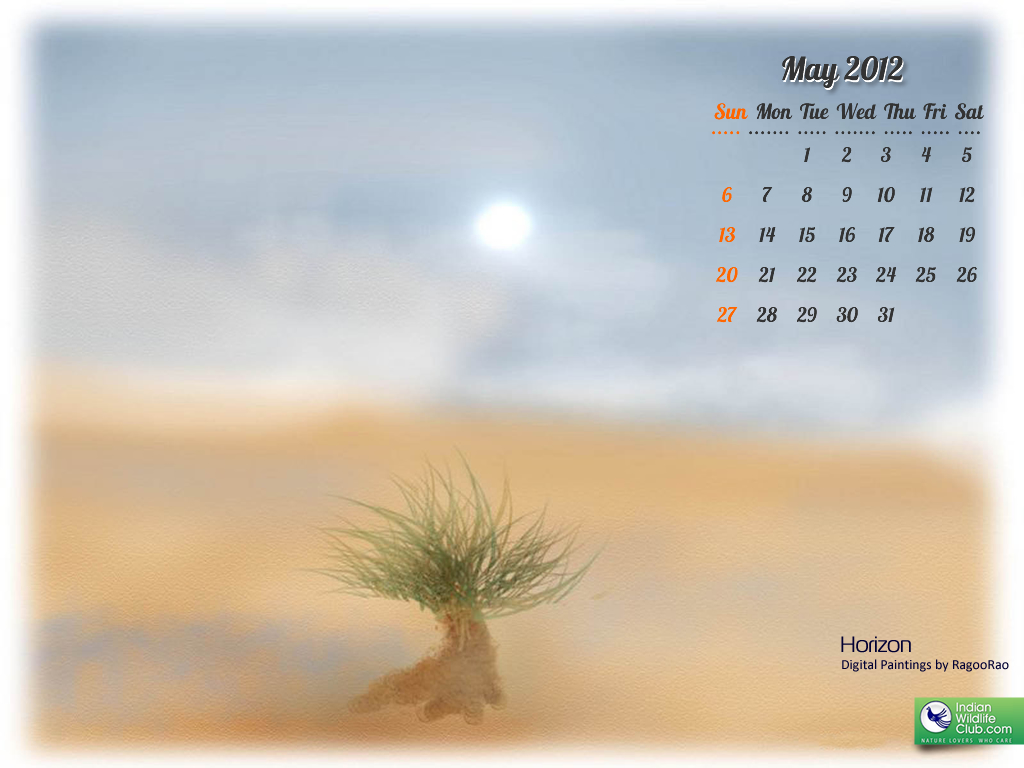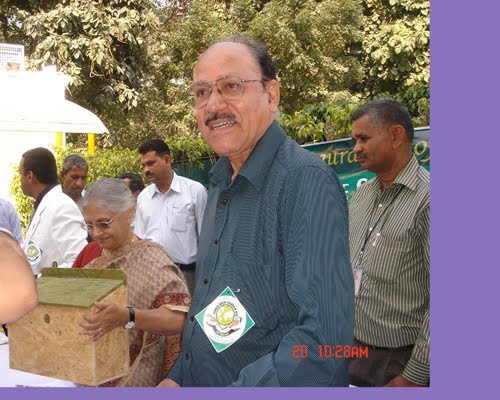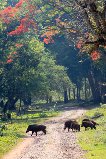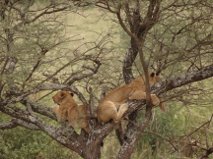Burning Issues
Man-Leopard Conflict
-Susan Sharma
Man wildlife conflict in India has reached disturbing proportions and it is high time we took note of this unpalatable fact. Our online chat on 15th April was on man leopard conflict.
"Ashvin Kumar: I choose this theme because of my concerns and asked myself how can I use my skills to tell this story so that more people understand why these animals need to be saved.
John H. Eickert: Why do they need to be saved?
Ashvin Kumar: But for my film to work, it has to work primariy as an entertainment.
mani: just read an article.. abt leopard problem near Krishnagiri Dist, TN
Ashvin Kumar: John, because they are co inheritors of our earth
mani: The leoaprds are coming from the hills during the dry season looking for easy pickings to the villages.
John H. Eickert: I am delighted that you wrote that, thank you.
Shashi Kant Sharma: Another reason will be, unless they are around, forests will simply disappear and the environment equilibrium lost
a j mithra: Do u think ur film would be seen as an entertainer or as a warning to the policy makers in the city?
Ashvin Kumar: Shashi - yes that and the fact that they tell us what its like to live as we were intended.
John H. Eickert: I agree, Shashi.
Ashvin Kumar: AJ i can't comment on that - you'll have ot see for yourself and make up your own mind. ALl I can say is that there will be talk about it.
John H. Eickert: I believe that we are intended to live in harmony not conflict and that all life is sacred.
Ashvin Kumar: I don't discount cities and the comforts and conveniences of urban life. But can that not co exist with this, this is the question.
a j mithra: Hope for the best.. Would be the happiest person if ur film makes a difference in conservation.. "
The above is an extract from out online chat of 15th April 2012 where we discussed the topic with Ashvin Kumar, whose film "The Forest" is based on this theme. See a preview by clicking on the link below.
http://www.indianwildlifeclub.com/admiz/Video-Preview.aspx?vid=205

Man -leopard conflict in India has been the subject of films and plays in India for some time now. The issue is so complex that a soltion to the problem can be found only if man learns to live in harmony with nature.
Sohal Jaffri has uploaded a youtube video which looks at this problem squarely in the eye. See the short film at the following link. The film can be watched in youtube through our channel Wildbytes.tv. "Where the Himalayas Bleed"
http://www.indianwildlifeclub.com/admiz/Video-Preview.aspx?vid=204
Vidya Arthreya, who has done years of research looking into the man leopard conflict in Western India, has produced a series of plays which highlight the issues involved. The plays are in Marathi but anyone with knowledge of Hindi can comprehend the plays
which are delightfully done.

All the four plays can be watched in youtube through our channel Wildbytes.tv. The series is called "waghoba_cha_khatla"
http://www.indianwildlifeclub.com/admiz/Video-Preview.aspx?vid=194
Share this article with as many as you can. A small effort in spreading awareness will go a long way!
|
Calendar of the month
RagooRao from Mysore has done some
beautiful digital paintings, which we have converted into monthly calendars. Please download these calendars free and use them as your desk top wall paper.
By clicking on RagooRao's name, you can read the numerous articles he has written for IndianWildlifeClub.com. He is also a superb nature photographer.
To download the calendar suitable for the size of your desktop, please click here

|
Eco-travel
-Parth Joshi
Community based tourism models arose out of settlements in extreme natural environments, where businesses and domestic chores were blended into one fabric of small, self-sustained village economies. Early explorers were attached to the communities, a relationship
largely defined by the adverse conditions, making ‘giving back’ more a matter of the emotional connect to the places and people, the need to preserve ‘memories’ rather than a conscious act of charity.
As tourism evolved globally from a business model into a tool for ensuring uniform diffusion of the socio-economic benefits, as well as a means of conservation with respect to biodiversity (a topic now increasingly coming under the scanner, but more due to
mismanagement rather than a flaw in the concept), niches like ecotourism, responsible tourism, sustainable tourism started emerging, bound together by a common idea but the approach differing in the sect of the natural and built environment they sort to address.
Community based tourism models, with their primary focus being the sustenance of the local community in harmony with the surrounding environment to ensure sustainability, blend in naturally.
Advantages of Cooperative Tourism Models
![]()
![]()
![]()
![]()
In India, the genesis of community based tourism can be looked upon from two distinct perspectives: one, the mountaineers in the Himalayan regions who connected with remote communities in the north and north eastern states, and the natural adversity left a
mark upon their lives, which either kept them coming back or ensured the communities had a well wisher in the outer world. The other aspect is the Green Revolution; with HYV seeds and increasing mechanization, productivity improved, but with a drop in employability.
The cooperatives were mostly agrarian though, as tourism had not grown into prominence as a medium for ensuring inclusive growth. Tourism, as a countermeasure, through the ‘umbrella’ implies that not only there is employment generation due to tourist demand,
but the economic benefits thus accrued are dispersed across a multitude of sectors based upon the services the tourist uses.
Actual focus on community based models can be said to have in Kerala, with cooperatives in Alleppey and other regions coming up in the 80s, with the simple aim of removing the ‘servant-master’ dichotomy of the service sector by making the villagers manage their
own businesses. Another advantage of the cooperative model being that exit strategies for the government and other external agencies is easier once capacity building or other form of development plans have been put in place.
The biggest draw in cooperative models is its ability to ensure that the economic benefits are evenly dispersed across the entire value chain. The basic premise starts from query handling procedures. Instead of individual establishments advertising themselves,
the destination is represented and promoted through a single brand that takes queries through a central system, and based upon the occupancy and services patterns of past visits, allocate the principles (read accommodation, guiding, transport, activities,
groceries, food etc.) accordingly.
With the turn of the century, as the tourism landscape in the country witnessed a surge in both domestic and inbound numbers with economic growth, expansion in infrastructure and active promotion my the government brought tourism in the league of sectors identified
as socio-economic enablers. Policies pertaining to development of infrastructure and human resource are increasingly being executed, and models have started mushrooming in all corners of the country, from the snow covered peaks of Uttarakhand and Himachal
to the distinct culture and tea gardens of the north east to the agrarian bounties of the flood plains. Almost every progressive Indian state has recognized rural tourism as an important cog in the quest for holistic development, and its flexibility with self-managed
models lends it an operational credibility.
The cooperative movement also holds importance in the Indian context for its contribution towards women empowerment, as instances all across the country (ranging across a vast sect of the rural business scape, from agriculture to food processing to handicrafts
to microfinance) have shown that women groups from NGOs to SHGs have been active participants in such initiatives. The ‘of, for and by’ the people approach ensures that the management rests within the community, and there is minimal impact upon the environment,
apart from reduction in economic leakages. Tourism start-ups require relatively small investments, which can be secured through institutional grants and loans or self help groups. Add to that the cross-cultural interaction, the ‘experience’ also works towards
bridging the ‘urban-rural’ divide.
However, taking the concept out of theory into the field has posed some challenges. The financial aid is often not seeping into the vital components of developmental support, especially the supporting infrastructure like accessibility, safety, wayside amenities,
telecommunication etc. market linkage is another vital component that further needs to be broadened. While the government can take care of the former, community support is essential for building a competent human resource. The future looks bright for the niche
though, with domestic clients warming up to the concept and the tourist experience gradually shifting from ‘leisure’ to an ‘experiential’ ethos.

Suggested Readings:
• George, B. P. (2007). Alleppey Tourism Development Cooperative:The Case of Network Advantage. The Innovation Journal: The Public Sector Innovation Journal , 10.
• Equations. (2006, June Tuesday). From Rural Tourism to Sustainable Rural Tourism. Retrieved July 19, 2011, from Scribd: http://www.scribd.com/doc/30280608/From-Rural-Tourism-to-Sustainable-Rural-Tourism-History-to-Current-Debates
• Hatton, M. (2002). The Character of Community-Based Tourism. Retrieved July 19, 2011, from Community Based Tourism in the Asia Pacific: http://cullin.org/cbt/index.cfm?section=chapter&number=1
• Varma, P. S. (2011, March 8). APTDC plans big . The Hindu .
• Institute, T. T. (1997). REST Project.
• Corbett Village Eco Tour. (n.d.). Corbett Village Eco Tour. Retrieved July 22, 2011, from Corbett Village Eco Tour: http://corbettvillage.in/
(Parth Joshi can be contacted at parth.rkt@gmail.com)
"I belong to a small town in the lap of the Himalayas; hence nature has always had this lure for me since childhood. Forever enthralled by the concept of logic and its limitations, my research interest lies in the carrying capacity of Himalayan townships and
developing the concept of geotourism, since ecotourism in India is presently reduced to the concept of mitigation rather than focusing upon awareness and participation. Photography, poetry and mountain biking are a passion."
|
Environment Education
Online Courses
-Susan Sharma
Last date for applying for the courses extended upto 10th June 2012
India is a hotbed of bio diversity. Yet Indians have little knowledge about our natural resources. Why?
The Internet population in India is growing exponentially. Yet there is no ONLINE course exclusively catering to Indian flora and fauna which can sensitize a person to his immediate surroundings. Why?
Environmental management is an industry that promises a growth in opportunity over the coming decades. Despite this fact though, graduates from environmental courses often find it difficult to gain the employment they hoped for. One must ask why?
IndianWildlifeClub, the community of nature lovers who care, are proud to partner with the Bombay Natural History Society (BNHS) to bring their online certificate courses to our members.
Certificate programs on offer

Study Environment Management and lead the conservation activities in your area. Complement your knowledge with the help of experts in the field--All by sitting at home!
Join a course that will give you a mix of skills that will always be in demand.
Ecology
Issues and Environmental Concerns
Environmental Law
Sustainable Development
Floral Diversity
Insect Diversity
Marine Diversity
Diversity of Herpetofauna
Mammalian Diversity
Bird Diversity
Suitable for students, working professionals or just about anyone with a curious mind - without having to take time out from work or other commitments in order to study.
The Conservation Education Center of BNHS is managing these online courses. Dr.V.Shubhalaxmi, Center Manager is the Course Co-ordinator. Shubhalaxmi has over fifteen years of experience in conservation education in India and she is a IN Fulbright Scholar who
holds a doctoral degree in Entomology and certificate from Boston University in Environmental Conservation Education.
The course tutors are skilled professionals who are fully qualified in the various subject areas. In addition, they combine their qualifications with many years of actual practical experience.
Join Now!
IndianWildlifeClub members are getting a discount of 5% on the course fee for the two courses which are on offer as online programs.
You can fill in the application form online and also pay the course fee online using our secure payment gateway. All major credit cards/debit cards and bank accounts can be used for making the payment.
Courses offered (Click on the links for further details)
Leadership Course in Biodiversity
Basic Course in Entomology

Director, BNHS Dr.Asad Rehmani in Delhi with the CM.
|
Environment Education
The last date of application has been extended to 10th June 2012
Courses offered (Click on the links for further details)
Leadership Course in Biodiversity Conservation
Basic Course in Entomology
Answers to Frequently Asked Questions on the online Environmental program offered by BNHS
1. The course is conducted from Mumbai office however since it is a online course anyone can enroll for the same. Apart from the inaugural and wrap-up camp which are held in Mumbai, all the other course activities can be done at your place. You just have to
travel to Mumbai only for two weekends once in June 2012 for the inaugural camp and then in May 2013 for the wrap-up camp.
2. Local Day Trips: There are 8 day-trips planned throughout the year. Students are expected to attend 5 trips on compulsorily basis to receive full grades. Outstation students have a facility to do the day trip at a forest patch nearby their place.
3. Field Camps: There are 5 camps organized throughout the year. Out of five camps Students are expected to attend 3 camps on compulsorily basis to receive full grades. In these three camps students are expected to attend the Inaugural and Wrap-up camps on
compulsorily basis. In case of the third camp students also have facility of attending BNHS membership camps as per their convenience.
4. Following are the camps scheduled for the course:
30 June-1 July 2012 : Inaugural Camp at Mumbai (compulsory)
25-26 May 2012 : Wrap-up camp at Mumbai (compulsory)
Participation in one of the following camp is compulsory:
14-16 September 2012: Mahableshwar, Maharashtra
24-28 September 2012: Chakrata, Uttarakhand
27-28 October 2012 : Malshej, Maharashtra
27th October to 1st November 2012 : Namdapha National Park, Arunachal Pradesh
8-12 April 2012: Bhagsu, Himachal Pradesh
5. Regarding the chat sessions they are scheduled on weekends from 6p.m. to 7 p.m. as per the availability of the SME.
6. Contact details of BNHS
“Bombay Natural History Society, Conservation Education Center, Near Film City, Goregaon (East), Mumbai- 400065. Telephone: 9594929107 / 9594929107. Email:cecbnhs@bnhs.org
Team IWC
|
Film Reviews
-Susan Sharma
"An out and out wildlife movie" I remarked to my son after we came out of the PVR cinema on Saturday. "How can you say that? I did not like it" remarked my son. Two extreme reactions, I thought to myself, typical of the interests and the generations we come
from. "But why did you not like it?" I asked. " I wish they had shown more of the jungle rather than adding the masala elements of a Hindi commercial cinema". I could see my son was angry. He is himself a great forest lover, having trekked in many,
watched wildlife in many more. What was the need to make the triangle love story the focus? he went on. Then I understood. Here was a movie which brought out raw emotions almost unwittingly. I also
understood why a young woman in the theatre had burst out laughing aloud at a poignant (and terrifying) moment in the movie, forcing some of the theatre guards to come inside and check.
Ashvin has touched some raw nerves here. He has touched me who claims to have studied man-animal conflict in some detail. He has touched the youngster who is a nature lover to be angry or react in a bizzaire fashion as though these trumped up emotions can
wash away reality.
Jaaved Jaafri stood tall in his acting and by the refreshingly handsome looks. As the Wildlife Warden of Corbett National Park, who studied and worked in London before he surrendered to nature, his brawn and brain far outwitted the "Axe effect" of the page
3 couple from the city. The Forest Guard was almost like a tribute to the many who get killed in their line of duty-yet realistically enacted by Shukla.
But I do have some questions for Ashvin. Was it really necessary to show the wildlife warden breaking all rules of the National Park to please his former lady love and her husband? Also here is a guide (the warden) who did not think it necessary to point
out and identify the most beautiful bird life Corbett had to offer. The beautiful shot of an osprey went uncommented. The highlight was the sighting of the tiger family.
Do sadhwis really roam about the protected forests on foot? Staying inside the forest rest house, should the guest be shown doing her morning pooja with a loud clanging of bells and the blowing of a conch shell? If the idea was to remind us of the many
religious places which still exist inside the deep forest attracting large crowds walking on foot inside, I feel this may have been handled differently.
Unlike the pin point focus of "The Little Terrorist", "The Forest" seems to have opened up a pandora's box of issues. But then why not? With the information overload of the digital age, we can handle them all in a span of one hour and twenty minutes, can'we?
See for yourself. Go and watch the movie.
Man-leopard conflict raises its ugly head through the cries of Zaidi (Jaafri's son in the movie), whose sense of the forest enables him to realise that the just severed head of a goat lying around the temple is the left-over of a meal by the leopard. It stares
at you through the half eaten body of a baby. There is a reminder every time the Forest guard appears with his battle scarred head . The injury is visible only when he turns his head to the right, so that the Director is able to use to good effect in
the movie. Bringing this conflict right into the drawing room of a city couple might sound dramatic, but is actually terrifying. The leopards from Sanjay Gandhi National Park prowling the ground of IIT Mumbai, the sensational case of a boy from an upmarket
residential colony being lifted by a leopard -all these news items crowd the mind as one listens to Zaidi talking about the man eating leopard. Here is a trailor of the movie.
http://www.indianwildlifeclub.com/wildbytes/index.aspx?vid=WI7Bv-jnOYI
|
Photography
Online photo exhibition
-Susan Sharma
IndianWildlifeclub used to organize phtography exhibitions in Delhi of selected photographer members. We have organized four such exhibitions
called "Wildscapes" (http://www.wildscapes.net/exhibition.aspx).
In this digital age where “everyone is a photographer”, we decided that the time is ripe for starting online photo exhibitions. The 3D wall photoexhibition by members, is a new feature we have added.
http://www.wildscapes.net/photoExhibition.aspx
What makes a good photograph? Great photos are easy to spot. We know them when we see them, but hard to pin down and define what exactly makes them great. For me a great photo has all the elements of a good photo and has the abilty to connect with the viewer
instantly. Composition, good light, aesthetics, expression, capturing a moment, etc have become so much easier to manage, thanks to the era of digital cameras with loads of simple to use feaures. But is the photograph telling a story?

That something else is hard to define and it varies depending on what you are looking for. It could be mistery, subtlty, a feeling of uneasyness or that "something" which makes you keep looking – rather than flicking onto the next one. There has to be an element
that causes you to remember that photo and will make you go back and look at it again and again. Something that the photographer brings to the image that is greater than the sum of all of its parts, and gives more than a depiction of a scene, or what one might
have seen with the naked eye.
In this digital age where “everyone is a photographer” is it becoming more and more difficult to take a great picture? We don’t think so. There are more good pictures, but the great ones still stand out. The digital age has brought scores of new people to
the photography industry. With all the advanced technology and automation it has made the industry very appealing to thousands of newcomers.
Photographers have so many other associations to their images, i.e. the experience they had when taking the photo. The important information is what can be taken from the image itself – everything else is supplementary. It helps to trust someone else who has
a more neutral response to select your best images. Hence we curate your photos to a theme so that the photos tell a story, with an underlying theme.
We look forward to IWC members coming forward with their best photos on nature and wildlife. Send about 30 pictures-you can upload them on picasa and send the link too- for us to choose from. The photos must have captions and also details about when and
where taken. Send a two line write-up about you-the photographer along with a link to your own web page. Those who want to buy high resolution images from you will contact you directly. IWC will expect you to give link to the phtogallery once the photos
are uploaded.

|